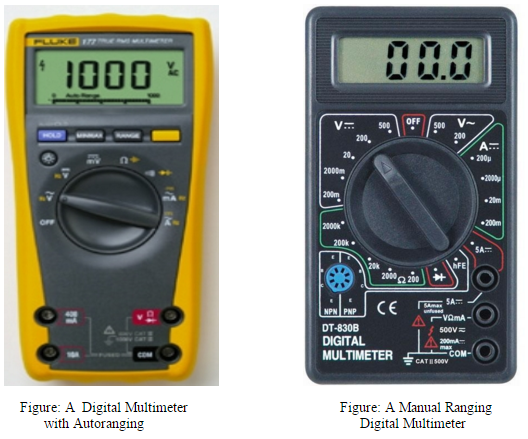What is the Advantage of having Autoranging on a Digital Multimeter?

Autoranging is a great advantage to have on a digital multimeter. Autoranging saves you the hassle of having to know which range of value the resistance, capacitance, voltage or whatever electrical characteristic you’re finding falls under. The multimeter finds the value for you. With a manual ranging multimeter (no autoranging), there are preset ranges, and you have to know which range of value your component falls under to get the value reading.
Say, you have a resistor:

If you don’t know
how to read the
color code of a resistor, you basically
have no idea which range of resistance it falls in. With a
manual ranging multimeter, you would just have to keep
measuring
the resistor by flipping from one range to the next until you are in
the correct range and get a
reading.
Typical ranges of resistances on a manual ranging multimeter are 0Ω-200Ω,
200Ω-2KΩ,
2KΩ -20KΩ, 20KΩ -200KΩ, 200KΩ -2MΩ, 2MΩ -20MΩ. If you had started from
the
first resistance range, you would have switched the notch 5 times
before you
got the readout of 20MΩ ±5%, which is what the above resistor is, since
it falls into the last
range of
2MΩ-20MΩ. With autoranging, all you do is switch the notch to the
ohmmeter
(resistance reading), with no need to adjust any ranges within the
resistance,
and you would have gotten the digital value readout automatically. This
is the
advantage of a DMM with an autoranging feature. It saves the hassle of
switching through various preset ranges and finds the value
automatically for you.
Autoranging
multimeters are more
expensive but
well worth the price. Even if you are proficient at reading the color
code of
resistors and other electrical components, it’s still a good
idea to
have one. For one, a component could be bad. You might have the manual ranging
multimeter on the range of what the component should be, but if
it's bad, it can literally be in any range. To save the hassle
of switching from range to range to find its value, an autoranging
multimeter will find it automatically for you. Another prime example of using an autoranging multimeter is when
troubleshooting a circuit for voltage. If you’re reading the voltage of a
circuit and
you’re expecting a value of around 5V, you’re going to have the DC
voltmeter in
the range of 2V-20V when in actuality, if your circuit is bad, it can
be below
that range or if something is really wrong, above that range. This is
why it’s
a good idea to have an autoranging multimeter. But rest assured, if you can’t get
one, a manual ranging multimeter can work just fine.
